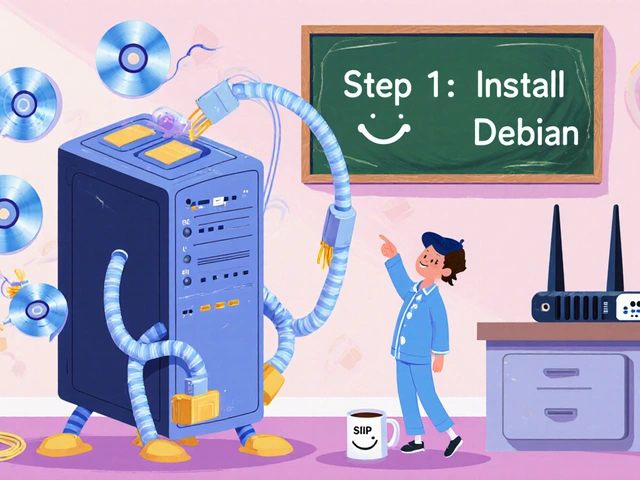Most businesses still treat phone calls like old-school landline events - a ringing phone, a person answers, and the conversation happens in a black box. But what if your phone system could talk to your CRM, your ticketing tool, your inventory system, or even your AI chatbot? That’s not science fiction. It’s what VoIP API integrations do every day. They turn your voice calls into data streams that trigger actions, update records, and automate workflows - without needing a single physical phone line.
Think about this: a customer calls your support line. Instead of your agent manually typing in their name, order number, and issue, the system instantly pops up their full history - past purchases, recent support tickets, even their last chatbot interaction - all because your VoIP API connected the call to your CRM. That’s not a nice-to-have. It cuts average handle time by 35%, according to UCStrategies. And it’s not rare anymore. Sixty-eight percent of medium and large businesses now use some form of VoIP API integration, mostly because remote work made old phone systems useless.
How VoIP APIs Actually Work (No Jargon)
A VoIP API is just a set of instructions your software can use to make, receive, and manage phone calls over the internet. It’s like giving your website or app a voice. You send a simple command - say, "call this number" or "get the last 10 calls from this customer" - and the API handles the rest. Behind the scenes, it uses standard protocols like REST and WebSocket to send data back and forth, usually in JSON format. No hardware. No proprietary boxes. Just code talking to a cloud service.
Here’s what you can actually do with it:
- Automatically start a call when a customer submits a form on your website
- Log every incoming and outgoing call directly into Salesforce or HubSpot
- Build a custom IVR that asks "Are you calling about billing or tech support?" and routes the call based on the answer
- Send SMS alerts when a call is missed or when a support ticket is resolved
- Record calls and feed them into AI tools that summarize key points in real time
Companies like Twilio, 3CX, and Wildix offer these APIs. But you don’t need to be a coder to get value. Many integrations work out of the box with Zapier or Make.com. You can connect a VoIP API to your CRM with drag-and-drop tools - no Python required.
What You Can Automate (Real Examples)
Automation is where VoIP APIs start saving real money. Let’s look at a few real cases:
Example 1: E-commerce Order Confirmation
An online store gets an order at 2:17 PM. Within 3 seconds, the VoIP API calls the customer to confirm shipping details. The system plays a recorded message, then asks: "Press 1 to confirm, 2 to change address." The customer presses 1. The system logs the confirmation, updates the order status to "confirmed," and sends a thank-you email. No human touched it. That’s 150 calls per day automated - and zero missed confirmations.
Example 2: Sales Team Screen Pops
At TechSupport Inc., agents used to spend 45 seconds per call logging details into Salesforce. After integrating 3CX’s API, every incoming call triggered a screen pop: the caller’s name, last purchase, open tickets, and even their social media profile. Logging time dropped to 8 seconds. Sales conversion jumped 22% because reps had context before they even said hello.
Example 3: Healthcare Appointment Reminders
A clinic uses a VoIP API to call patients 24 hours before their appointment. If the patient answers and says "I can’t make it," the system books a new time and updates the calendar. If they don’t answer, it texts them. If they say "I’m here," it sends a QR code for check-in. This cut no-shows by 41% in one clinic’s pilot.
These aren’t theoretical. They’re happening now. And they’re all built on the same basic idea: turn voice into data, then use that data to act.
Choosing the Right VoIP API Provider
Not all VoIP APIs are the same. Here’s how to pick one that fits your needs:
| Provider | Best For | Per-Minute Cost (US) | CRM Integration | Setup Time | Uptime |
|---|---|---|---|---|---|
| Twilio | Startups, global scale | $0.0085 | Native with Salesforce, HubSpot, Zoho | 1-2 days | 99.5% |
| 3CX | On-premises, enterprise | Free (license required) | Deep Salesforce, Microsoft Teams | 1-2 weeks | 99.9% |
| Wildix | Businesses wanting no per-minute fees | $0 (annual license) | Basic CRM sync | 3-5 days | 99.8% |
| Plivo | High-volume SMS + voice | $0.0065 | Custom via API | 2-4 days | 99.7% |
| FusionPBX (Open Source) | Technical teams with time | $0 | Manual setup | 2-3 weeks | 99.6% |
Twilio is the most popular - 92% recognition in Gartner’s 2023 report - but it’s also the most expensive if you make lots of calls. Wildix and 3CX are better if you want to avoid per-minute charges. FusionPBX is free, but you’ll need a team that knows SIP, Asterisk, and server configs. Most businesses start with Twilio or 3CX because their documentation is clear, and their support teams respond fast.

What Goes Wrong (And How to Avoid It)
Forty percent of VoIP API projects fail - not because the tech doesn’t work, but because people skip the basics. Here are the top mistakes:
- Skipping IP whitelisting: Your API provider will ask you to list the IP addresses that can send requests. If you don’t, you’ll get 401 errors. One developer spent three days troubleshooting until he realized his AWS server’s IP changed every 24 hours.
- Ignoring TLS 1.2+: All modern VoIP APIs require encrypted connections. If your server uses old SSL, calls just won’t go through. Check your hosting provider’s security settings.
- Not handling call failures: About 5-7% of calls fail due to carrier issues. Don’t assume every call connects. Build retry logic - try again in 10 seconds, then 30, then give up and send a text.
- Forgetting time zones: If your call logs show calls happening at 3 AM, you probably didn’t convert timestamps to local time. Always use UTC in your API calls and convert on display.
- Leaking API keys: Never hardcode keys in your frontend code or share them in GitHub. Store them in environment variables. A single leaked key can lead to $10,000 in fraudulent calls.
Security researcher Jane Chen found that 15% of tested VoIP API setups had critical flaws - like unsecured API keys or unencrypted call recordings. GDPR fines for misused call data hit €142,350 in the EU in 2022. Don’t be the next headline.
Skills You Need (And How to Get Them)
You don’t need to be a software engineer to use VoIP APIs - but you do need to understand a few things:
- REST APIs: Know how to send HTTP requests (GET, POST) and read JSON responses. That’s it.
- Basic scripting: Python or Node.js are the most common languages. You can start with a 2-hour tutorial on Twilio’s site and build a working call script by lunchtime.
- Telephony basics: Understand terms like SIP, RTP, IVR, and CDR (call detail records). You don’t need to build them - just know what they do.
Stack Overflow’s 2023 survey found that 78% of successful integrations were done by developers with 2+ years of API experience. But that doesn’t mean you can’t do it. Use pre-built connectors. Use Zapier. Use Twilio’s helper libraries. Start small. Test one automation - like logging calls to Google Sheets - before trying to connect to your entire CRM.

The Future: AI, 5G, and What’s Next
VoIP APIs aren’t stopping. They’re getting smarter.
3CX released AI call analytics in September 2023. It listens to every call, flags angry tones, detects when a customer says "I’m leaving," and alerts managers in real time. Accuracy is 89% in beta. Twilio’s new WebRTC 1.0 API cuts browser compatibility issues by 76%. Vonage is building AI that summarizes calls in real time - think "Here’s what the customer said, here’s what they want, here’s the next step."
5G networks will drop latency to under 100ms, making real-time voice apps like remote surgery assistance or live language translation possible. And by 2026, Grand View Research predicts 35% of current VoIP API providers will be bought by bigger players.
But here’s the real takeaway: the best VoIP API isn’t the one with the most features. It’s the one that solves your specific problem. Whether you’re a small business trying to reduce missed calls or a global company automating 10,000 calls a day, the goal is the same: make your phone system work for you - not the other way around.
Frequently Asked Questions
What’s the difference between VoIP and VoIP API?
VoIP is the technology that lets you make phone calls over the internet. A VoIP API is a tool that lets your software control those calls - like sending a text, starting a call, or logging data. Think of VoIP as the phone line, and the API as the remote control.
Can I use a VoIP API with my existing phone system?
Yes - but it depends. If you’re using a cloud-based system like RingCentral or 3CX, you can usually connect their API directly. If you’re using old hardware phones, you’ll need to upgrade to a VoIP-compatible system first. Most modern business phones support API integration out of the box.
Do I need to code to use a VoIP API?
Not necessarily. Tools like Zapier, Make.com, and Microsoft Power Automate let you connect VoIP APIs to other apps without writing code. But if you want custom logic - like routing calls based on customer history - you’ll need a developer or learn basic scripting.
How much does a VoIP API cost?
Costs vary. Twilio charges $0.0085 per minute for US calls. Wildix has no per-minute fees but requires a $1,200 annual license. 3CX charges per user, not per call. Open-source options like FusionPBX are free but need technical setup. Most businesses spend $50-$500/month depending on usage.
Is VoIP API integration secure?
Yes - if done right. Always use API keys, IP whitelisting, and TLS 1.2+ encryption. Never store keys in code. Audit access logs monthly. The biggest risk isn’t the API - it’s poor setup. 40% of failures come from misconfigured security, according to Gartner.
What’s the easiest way to start?
Start with Twilio’s free trial. Connect it to Google Sheets and set up a simple automation: when a form is submitted, make a call to confirm. That takes under 2 hours. Once you see how it works, you can scale to your CRM or support system.
Next Steps
If you’re ready to try VoIP API integration:
- Identify one repetitive call task - like confirming appointments or logging sales calls.
- Choose a provider: Twilio for speed, 3CX for enterprise, Wildix for no per-minute fees.
- Use their free trial or sandbox environment to test.
- Start small: connect one app, automate one process.
- Measure results: Did handle time drop? Did conversion go up?
VoIP APIs aren’t about replacing humans. They’re about removing the boring, repetitive parts of phone work so people can focus on what matters - helping customers, closing deals, solving problems. The phone isn’t going away. But the way we use it? That’s changing - fast.










Kathy Yip
29 Oct 2025 at 21:38i keep thinking about how we treat phone calls like they’re sacred rituals-like if you automate them, you’re somehow being rude. but honestly, when i got that automated confirmation call after ordering my cat’s prescription, i was just glad i didn’t have to wait on hold. it felt less invasive than filling out a web form with my entire life story.
maybe we’re scared of losing the human touch, but what if the human touch is just… delayed? like, when the AI asks if i’m calling about billing, and i say yes, and then a real person pops on with all my info already loaded-that’s not cold, that’s thoughtful. it’s like the machine did the grunt work so the human could actually help.
i don’t know. maybe i’m just tired of being treated like a ticket number. but this? this feels like the phone system finally learned how to listen.